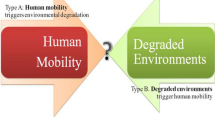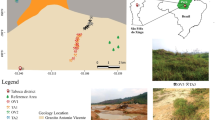Abstract
The increasing demand for building materials has led to indiscriminate exploitation of clay-rich topsoil from wetlands including the paddy lands of Central Kerala in the southwestern coast of India. The problem is critical in areas adjoining the major developmental centers having low per capita land and natural resource availability. Loss of fertile topsoil, shrinkage of agricultural lands and consequent food security issues, erosion of naturally evolved nutrients, lowering of water table in wells adjacent to the mining sites, etc., are some of the major environmental issues arising from indiscriminate brick and tile clay mining. Although, brick and tile clay mining brings short-term economic benefits and employment opportunities to a section of people, the process in the long run creates severe damages to the environmental settings of the area. The present paper deals with a few aspects of brick and tile clay mining in the paddy lands of Central Kerala, especially around Kochi City, a fast developing urban-cum-industrial center in South India, which demands large quantities of building materials including bricks and tiles for construction of infrastructural facilities. It is estimated that 729,695 tons/year (ty−1) of brick and tile clays are extracted from the coastal lowlands of Central Kerala, spreading to the Chalakudy (135,975 ty−1), Periyar (483,820 ty−1) and Muvattupuzha (109,900 ty−1) river basins. The N, P and K loss through extraction of brick and tile clays amounts to 210 ty−1, 96 ty−1 and 9,352 ty−1, respectively. As nutrient loss is an irreversible process in human time scale, its implications on agricultural productivity is a matter of serious concern. The study warrants the need for a comprehensive policy with an aim to regulate the mining activities on an environment- friendly basis in the densely populated coasts of the world, in general, and the study area in particular.






Similar content being viewed by others
References
APHA (1985) Standard methods for the examination of water and waste water. American Public Health Association, Washington
Bateman AM (1960) Economic mineral deposits (Indian Edition). Asia Publishing House, Bombay
De Leeuw J, Shankman D, Wu G, De Boer WF, Burnham J, He Q, Yesou H, Xiao J (2009) Strategic assessment of the magnitude and impacts of sand mining in Poyang Lake. China. Reg. Environ Change. doi:10.1007/s10113-0096-6
Department of Mining and Geology (2009) State government report, Kerala, India
El Wakeel SK, Riley JP (1957) The determination of organic carbon in marine sediments. J Du Conseil Perm Int Pour L’ Exploration De La Mer 22:180–183
Folk RL (1970) Petrology of sedimentary rocks. Hamphill, Texas
Galero DM, Pesci HE, Depetris PJ (1998) Effects of quarry mining and of other environmental impacts in the mountainous Chicam-Toctino drainage basin (Cordoba, Argentina). Environ Geol 34:159–166
GSI (1995) Geological and mineralogical map of Kerala. Geological Survey of India, Calcutta
Hankanson L, Jannson M (1983) Lake sedimentology. Springer, Berlin
Harilal KN, Andrews M (2000) Building and builders in Kerala: commodification of buildings and labour market dynamics. Discussion paper No.22, KRPLLD, Centre for Development Studies, Thiruvananthapuram, 30p
Hayward R (1978) The brick books. BT Batsford Ltd, London
ILO (1984) Small scale brick making. Technology service; technical memorandum no 6. International Labor Office and United Nations Industrial Development Organization, Geneva. 210p
Jiang L (1999) Population and sustainable development in China. Thela Thesis, Amsterdam
Keilman N (2003) The threat of small households. Nature 421:530–533
KSLUB (2006) Land resources of Kerala state. Kerala State Landuse Board, Thiruvananthapuram, p 108
Liu J, Daily GC, Ehrlich PR, Luck GW (2003) Effects of household dynamics on resource consumption and biodiversity. Nature 421:530–533
Murphy J, Riley JP (1962) A modified single solution method for the determination of phosphate in natural waters. Anal Chim Acta 27:31–36
Nair PRG (1994a) Migration of Keralites to the Arab world. In: Prakash BA (ed) Kerala’s economy. Performance problems, and prospects. Sage Publications, New Delhi, pp 179–195
Nair S (1994b) The high ranges problems and potential of a hill region in the southern western ghats. INTACH
Nair PRG (1998) Dynamics of emigration from Kerala: factors, trends, patterns and policies. In: Appleyard R (ed) Emigration dynamics in developing countries. Ashgate, Brookfield, pp 257–291
Padmalal D, Nair KM, Ruta BL, Kumaran KPN (2008) Late Quaternary evolution of Alappuzha–Kochi coast (Kerala), SW India. In: National symposium on geodynamics and evolution of Indian shield through time and space. Held at CESS, Thiruvananthapuram from 18–19 Sept 2008, pp 45–46
Padmalal D, Nair KM, Kumaran KPN, Sajan K, Vishnu Mohan S, Maya K, Santhosh V, Anooja S (2010a) Evidences of climate and sea level changes in a Holocene bay head delta, Kerala, Southwest coast of India. International Workshop on Climate Change and Island Vulnerability, Kadamat Island, Lakshadweep, 26–30 Oct 2010
Padmalal D, Maya K, Narendrababu KN, Baijulal B (2010b) Environmental appraisal and sand auditing of Manimala river, Kerala, India. Project completion report submitted to Revenue Department, Government of Kerala
Padmalal D, Kumaran KPN, Nair KM, Baijulal B, Ruta B, Limaye, Vishnu Mohan S (2011) Evolution of the coastal wetland systems of SW India during Holocene: evidence from marine and terrestrial archives of Kollam coast. Kerala. Quaternary International. doi:10.1016/j.quaint.2010.12.021
Pronk M (1997) Changing land use practices: motives and consequences of clay mining and brick production in Thrissur District, Kerala, India (Project Paper No II). Joint CDS (Centre for Development Studies)—GIUS (Geographical Institute, University of Zurich) Research Project on land use dynamics in Kerala: an actor-oriented approach. CDS, Thiruvananthapuram and GIUZ Switzerland
Sanfeliu T, Jordán MM (2009) Geological and environmental management of ceramic clay quarries: a review. Environ Geol 57:1613–1618
Santhosh V (2006) Environmental impact assessment of tile and brick clay mining from Chalakudy and Periyar river basins, Kerala, India. Ph.D Thesis, Kerala University, Unpublished
Saxena MM (1994) Environmental analysis of water, soil and air. Agro botanical publishers, India, p 232
Sreebha S, Padmalal D (2011) Environmental impact assessment of sand mining from the small catchment river in the southwestern coast of India. Environ Manag 47:130–140
Acknowledgments
We are indebted to Dr. N. P. Kurian, Director, Centre for Earth Science Studies (CESS, Thiruvananthapuram) for encouragements and also for extending necessary facilities for carrying out this study. We are grateful to Dr. K. N. Nair, Director, CDS and program co-ordinator, KRPLLD for constant support and encouragements. Financial assistance from KRPLLD (to DP and KM) and University of Kerala (to SV and BB) are also acknowledged. SV and BB thank Prof. (Dr.) V. Sobha, Department of Environmental Sciences, University of Kerala for encouragements and supports. We are thankful to the anonymous reviewers for their critical suggestions, which improved the scope of the paper.
Author information
Authors and Affiliations
Corresponding author
Rights and permissions
About this article
Cite this article
Santhosh, V., Padmalal, D., Baijulal, B. et al. Brick and tile clay mining from the paddy lands of Central Kerala (southwest coast of India) and emerging environmental issues. Environ Earth Sci 68, 2111–2121 (2013). https://doi.org/10.1007/s12665-012-1896-4
Received:
Accepted:
Published:
Issue Date:
DOI: https://doi.org/10.1007/s12665-012-1896-4




